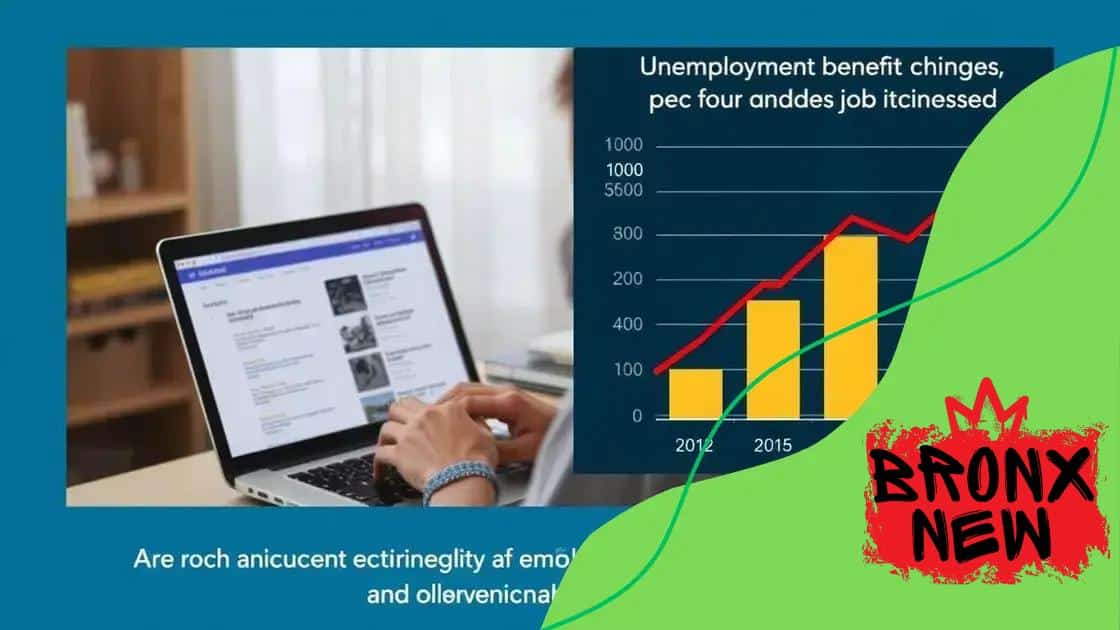Unemployment benefits policy shifts: what you need to know

Unemployment benefits policy shifts can significantly affect job seekers, altering the amount of financial support, eligibility requirements, and overall accessibility based on state regulations and future trends.
Unemployment benefits policy shifts can feel daunting, but they play a critical role in supporting many during tough times. Have you considered how new regulations might impact your situation? Let’s explore these changes together.
Understanding unemployment benefits
Understanding unemployment benefits is essential for anyone facing job loss. These benefits provide financial support during tough times, allowing individuals to focus on their job search without the added stress of lost income. However, knowing how these benefits work is vital to fully utilize them.
What Are Unemployment Benefits?
Unemployment benefits are payments made by the government to individuals who have lost their jobs through no fault of their own. The goal of these benefits is to offer temporary financial support while individuals seek new employment opportunities.
Eligibility Criteria
To qualify for unemployment benefits, you typically must meet a few requirements:
- Have worked a certain number of hours or earned a minimum amount in the previous period.
- Be actively seeking work during your time on benefits.
- Be able and available to work as required.
Each state may have different criteria, so it’s vital to check local regulations.
The amount you receive often depends on your previous earnings and the specific rules in your state. Sometimes, the benefit amount may be lower than your previous salary, making it important to budget effectively.
How to Apply for Benefits
Applying for unemployment benefits can usually be done online or in-person, depending on your state. It’s essential to have your work history and personal information ready when applying. Misleading or incorrect information can lead to delays or denial of benefits.
If you’re struggling to navigate through the application process, consider reaching out to local organizations that assist with job placement and benefits applications. These services can provide valuable support.
Unemployment benefits are designed to help you bridge the gap between jobs. Understanding what they entail will equip you with the knowledge needed to make the most of your situation. Whether navigating the application or utilizing the funds wisely, being informed is crucial for your success.
Recent shifts in policy
Recent shifts in unemployment benefits policy have created significant changes in how assistance is provided to job seekers. Many states have adjusted their benefits in response to the evolving economic landscape. These adaptations can affect the amount of support available and how quickly individuals can access it.
Changes to Eligibility Requirements
One of the most noticeable shifts has been in eligibility criteria. Governments may now require additional documentation or proof of job seeking to qualify for benefits. This means job seekers should be prepared to demonstrate their efforts actively.
- Increased emphasis on job search activities.
- Provision for gig workers and freelancers in some states.
- Changes in the minimum earnings threshold for qualification.
Such modifications can make a difference for many, particularly those in non-traditional work patterns. As policies evolve, understanding these changes becomes crucial.
Adjustments in Benefit Amounts
Another critical shift is how states determine the benefit amounts. Adjustments are being made not only to the maximum payment but also in the calculation methods used to determine the amounts. This can lead to differences in the financial assistance received, impacting budgeting strategies for individuals relying on these funds.
Additionally, some states are experimenting with temporary increases during economic crises. Keeping track of local updates will help individuals maximize their benefits. Changes like these highlight the necessity for ongoing awareness regarding unemployment benefits.
As local economies continue to fluctuate, staying informed of these recent shifts in policies can empower individuals as they navigate their next steps. Understanding how benefits are structured will assist you in planning your financial future effectively.
How policy changes affect job seekers

Understanding how policy changes affect job seekers is vital for anyone navigating the workforce today. New regulations can influence not just how benefits are distributed, but also the overall job market dynamics. These shifts can create both challenges and opportunities for job seekers.
Direct Impact on Benefits
When policies change, the most immediate effect is often on the benefits received by job seekers. Changes can include lower benefits amounts, an extended waiting period, or new eligibility criteria. For instance, if a state tightens its requirements, fewer individuals may qualify for support during their job search.
- Reduced benefit amounts can lead to financial strain.
- Increased requirements could hinder access to essential support.
- Expanded benefits may assist a wider range of job seekers, including gig workers.
Such variations can alter how individuals approach their job search, potentially influencing their decisions to accept lower-paying jobs just to secure a paycheck.
Effects on Job Search Behavior
Changes in benefits can also impact how actively job seekers pursue new employment. If benefits are sufficient, individuals may take more time to seek positions that align with their skills and preferences. On the other hand, if benefits are limited, job seekers may feel pressured to accept any available positions quickly.
This pressure can lead to job mismatch, where individuals take roles that do not fit their skills or career goals. Additionally, job seekers may be less likely to invest in further training or education if they feel rushed to find immediate employment.
Understanding these dynamics is crucial for both job seekers and policymakers. By analyzing how changes in policies impact job seekers, each side can work toward solutions that foster a healthy employment landscape.
Comparing state-level benefits
Comparing state-level unemployment benefits is crucial for understanding how different regions support their job seekers. Each state has unique rules and programs that can significantly impact how residents manage through periods of unemployment.
Variations in Benefit Amounts
One of the most significant differences is the amount of financial assistance offered. States set their benefit amounts based on various factors, such as average wages and employment rates. This means that job seekers may find that their support can vary widely based on where they live.
- Some states offer higher maximum benefits, making it easier for residents to maintain their living standards.
- Others may have lower benefits, which can increase financial stress during unemployment.
- States with high costs of living often adjust benefits upward to help residents cope.
This variation emphasizes the importance of knowing local policies when seeking unemployment assistance.
Eligibility Requirements
Eligibility requirements can also differ considerably between states. Certain areas may have stricter conditions that must be met before individuals can receive benefits. This includes factors such as:
- The duration of employment prior to becoming unemployed.
- Specific job-seeking activities that must be demonstrated.
- Requirements for reemployment, including whether individuals must accept any job offer.
These requirements can influence how quickly job seekers can access support and how they plan their job searches.
By understanding the comparative aspects of state-level unemployment benefits, job seekers can make more informed decisions about where to apply for assistance and how to prepare for potential employment changes. This knowledge can be an essential tool in navigating the job market effectively.
Future trends in unemployment assistance
Future trends in unemployment assistance are set to evolve significantly as economies adapt to changing job markets. As the world faces new challenges, the ways in which unemployment benefits are delivered may shift to better meet the needs of job seekers.
Increased Focus on Flexible Benefits
One trend likely to emerge is a greater emphasis on flexible benefits. This means that states may start tailoring assistance packages to fit individual circumstances. People with diverse work backgrounds and varying needs may benefit from customizable support.
- Benefits that adjust based on income or job type can better address unique situations.
- Flexibility in how funds can be used, such as for training or relocating, might become more common.
- Options for part-time work while receiving assistance could encourage a smoother transition back to full employment.
This flexible approach aims to support a wider range of job seekers, making it easier to adapt to the dynamic economy.
Embracing Technology in Benefits Delivery
Another significant shift could be the increased use of technology in providing unemployment assistance. Digital platforms may streamline the application process and reduce waiting times for benefits.
Using online portals and mobile applications will allow job seekers to manage their benefits more efficiently, track their job search progress, and access resources. Remote assistance through chatbots or virtual agents could enhance support while making it more accessible.
Furthermore, data analytics might be leveraged to identify trends in the job market. This could help align unemployment assistance policies more closely with economic needs, creating a proactive safety net for workers.
Overall, these future trends in unemployment assistance could transform how support is delivered, making it more responsive to the realities of today’s job market. Being aware of these potential changes will help individuals navigate their job searches with greater ease.
FAQ – Frequently Asked Questions about Unemployment Benefits Policy Shifts
What are unemployment benefits?
Unemployment benefits are financial assistance provided by the government to individuals who are unemployed through no fault of their own, helping them during their job search.
How can policy changes affect my unemployment benefits?
Policy changes can impact the amount of benefits received, eligibility criteria, and the overall availability of support, making it essential to stay informed about local regulations.
Are all states’ unemployment benefits the same?
No, unemployment benefits vary significantly between states, including the amount of financial assistance and eligibility requirements.
What future trends should I look for in unemployment assistance?
Future trends may include more flexible benefits tailored to individual needs and increased use of technology to improve the application and management of unemployment assistance.





